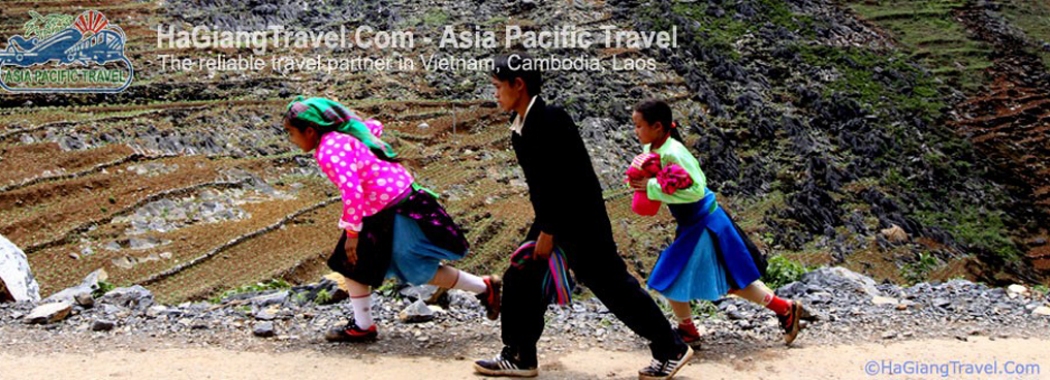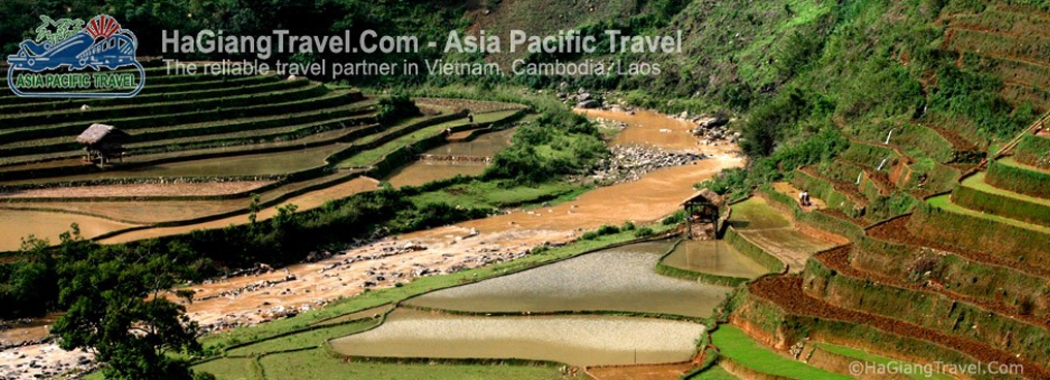Ha Giang is one of the less traveled place in Northern Vietnam. This area is still untouched to many Vietnamese travelers and foreign tourists. Here is an articles extracted from the New York Times. The article is written by JENNIFER BLEYER and is published on the New York Times on October 27, 2010.
MY first glimpse of the place that some call Shangri-La came on a brisk spring afternoon as we were careening along a narrow road hemmed in by sheer limestone walls. Our driver made a hairpin turn and all at once the landscape erupted into a sweep of dazzling slopes, serrated ridges and hanging valleys. In the pocket of a mountain pass called Heaven’s Gate, Hoang Tuan Anh, who also served as our guide, stopped his pickup truck so we could gaze at the vista of radiant sky that had opened up before us. This was only the beginning, Mr. Anh said, as we resumed our upward drive. “We will go as high as the clouds!”
My husband, my daughter and I had been in Vietnam nearly a month before we visited Ha Giang province in the northern reaches of the country. It was a place I had never heard of, but Vietnamese acquaintances talked about the region as if it were the Land of Oz, their eyes widening as they incanted its name (pronounced Ha ZAHNG). Worldly young Hanoians said that one could not truly consider oneself Vietnamese until having been there. Expatriate friends implored us not to squander any opportunity to experience this holy grail, far from the country’s deeply trodden tourist track.
Such reverence, we soon learned, was warranted, and it wasn’t just because of the region’s spectacular landscape. In an ever-shrinking world, Ha Giang, with its uniquely preserved tribal culture (nearly 90 percent of the population is ethnic minorities), is one of those rare places that hasn’t been corralled by modernity or prepackaged for visitors. At least, not yet. During the past two decades, as Vietnam’s lowlands and urban centers have teetered on tracks of globalization and economic development, much of this distant 5,000-square-mile province has remained detached and frozen in the past.
That isolation has been reinforced by strained politics, but in recent years, border tensions stemming from a 1979 Chinese invasion have thawed, the government has poured money into improving the province’s roads and other infrastructure, and new, albeit modest, hotels have arrived. Middle-class Vietnamese already appear in throngs, and foreign visitors have begun trickling in as well — last year some 3,500 foreign tourists visited the region. That figure seems poised to grow since the Dong Van plateau, at the province’s northernmost edge, was named the country’s first Unesco-designated Global Geopark earlier this month, a status that the organization bestows on places of significant geological and cultural heritage. The 900-square-mile plateau is studded with ethereal karst formations, evidence of tectonic events that started molding the area over 400 million years ago.
It was that plateau that beckoned to us, as it does to most travelers who venture to the region.
The overnight train from Hanoi deposited us at dawn in Lao Cai, a blustery northern city about 70 miles west of Ha Giang. There we boarded a crammed local bus that chugged for eight hours through misty hills. We spent part of the afternoon lodged in a mudslide, only to be rescued by a hydraulic backhoe doubling as a tow truck. Our 11-month-old daughter craned her head and stared quizzically through it all, as if we were toting her through some particularly mountainous corner of the Upper West Side.
In Ha Giang’s sleepy provincial capital, the city of Ha Giang, we were met by Mr. Anh, our guide of Tay ethnicity with whom we had arranged a three-day tour — first to Dong Van, a town that was less than two miles from the Chinese border, and then along a mountain road to the town of Meo Vac. Mr. Anh escorted us to the concrete headquarters of the immigration police to procure $10 permits from an unsmiling official. Although the requirement was abolished in most of the country in 1993, foreigners are still expected to obtain permits to tour Ha Giang, a Communist rite of the rubber-stamping variety so seldom experienced by travelers in modern Vietnam as to seem almost quaint.
Later, as we barreled past the limits of Ha Giang city into the area’s remarkable landscape, Mr. Anh, a garrulous man in his late 30s who had studied in England and lived in Hanoi before returning to his native Ha Giang, recounted how his parents would spend days during their youth walking the winding route to Dong Van before there were paved roads. Our trip, he said, would take a mere six hours.
THE story of Ha Giang is in many ways the story of the proud and independent Hmong who, following the Tay and other ethnic groups, began migrating there in the late 18th century, fleeing unrest in southern China. In Ha Giang, they found the high altitudes they were accustomed to, and alkaline soil in which their opium poppy crops would flourish.
Buffeted by the political winds that blew through Vietnam in the past century, the Hmong and other minorities occasionally rebelled but mostly cooperated with the French colonists and, subsequently, with the ruling Viet Minh, who promised them a degree of autonomy in exchange for their support. (They ultimately reneged on that promise.) The overriding desire to remain free and secure was challenged during the 1979 Chinese invasion; border flare-ups persisted for years, but by 1991, relations were normalized between the two countries, and negotiations led to a final decision last year about where the 800-mile border would be. Although one of the poorest provinces in Vietnam, with little industry besides mining and agriculture, Ha Giang was once again safe for the Hmong and others, and visitors began to show up…
On such sites, and we'll tell now. As an illustration, I can say that www.cialis.com is not a bad option. Together with his junior brother cialis.com they took a immense market for the sale of animals.





